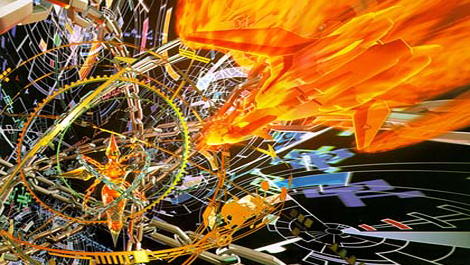


—by Charles McCarter
Even if you don't know it, you've seen computer generated (or "digital")
animation in your favorite anime titles. Animators are always searching
for tools to make their lives easier and their work better. And if that
wasn't enough of an incentive, in these days of budget cuts and recessions,
studios are looking for new ways to cut costs without decreasing production
values. One way to do this is by embracing computer animation.
 A wide variety of computer programs are available to assist with animation
production. Many of these are being adapted for use in some of the larger
studios in Japan today. For more information, take a look at last issue's
Digital Animation
Primer. A wide variety of computer programs are available to assist with animation
production. Many of these are being adapted for use in some of the larger
studios in Japan today. For more information, take a look at last issue's
Digital Animation
Primer.
 However, despite its growing use within the industry, computer-generated
animation still has negative connotations. Many people, both professionals
in the industry and fans, consider CG animation to be
three-dimensional polygons with ugly features and no shading. However, even
though 3D CG has come a long
way, as a look at many of today's video games will demonstrate, it's not what
people associate with "animation," nor is it necessarily what they want to see. However, despite its growing use within the industry, computer-generated
animation still has negative connotations. Many people, both professionals
in the industry and fans, consider CG animation to be
three-dimensional polygons with ugly features and no shading. However, even
though 3D CG has come a long
way, as a look at many of today's video games will demonstrate, it's not what
people associate with "animation," nor is it necessarily what they want to see.
 But that's certainly not the only use. Many animation studios are
applying computers to deal with some of the more labor and time intensive
tasks involved in creating anime, such as cel painting. In addition, many
programs allow directors additional flexibility regarding camera work and
composition. Quite often, they can preview the work with several different
sets of options before a final "print" is made. As a result, many directors
are turning to this new tool to assist them in their productions. But that's certainly not the only use. Many animation studios are
applying computers to deal with some of the more labor and time intensive
tasks involved in creating anime, such as cel painting. In addition, many
programs allow directors additional flexibility regarding camera work and
composition. Quite often, they can preview the work with several different
sets of options before a final "print" is made. As a result, many directors
are turning to this new tool to assist them in their productions.
 In 1994, 44 television anime productions used computer-assisted animation.
In 1996, that number nearly doubled as it increased to 70 productions. The
numbers continue to rise, although not as dramatically, from year to year.
This year, even more anime will be produced with digital assistance. In 1994, 44 television anime productions used computer-assisted animation.
In 1996, that number nearly doubled as it increased to 70 productions. The
numbers continue to rise, although not as dramatically, from year to year.
This year, even more anime will be produced with digital assistance.
 |

